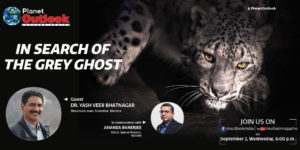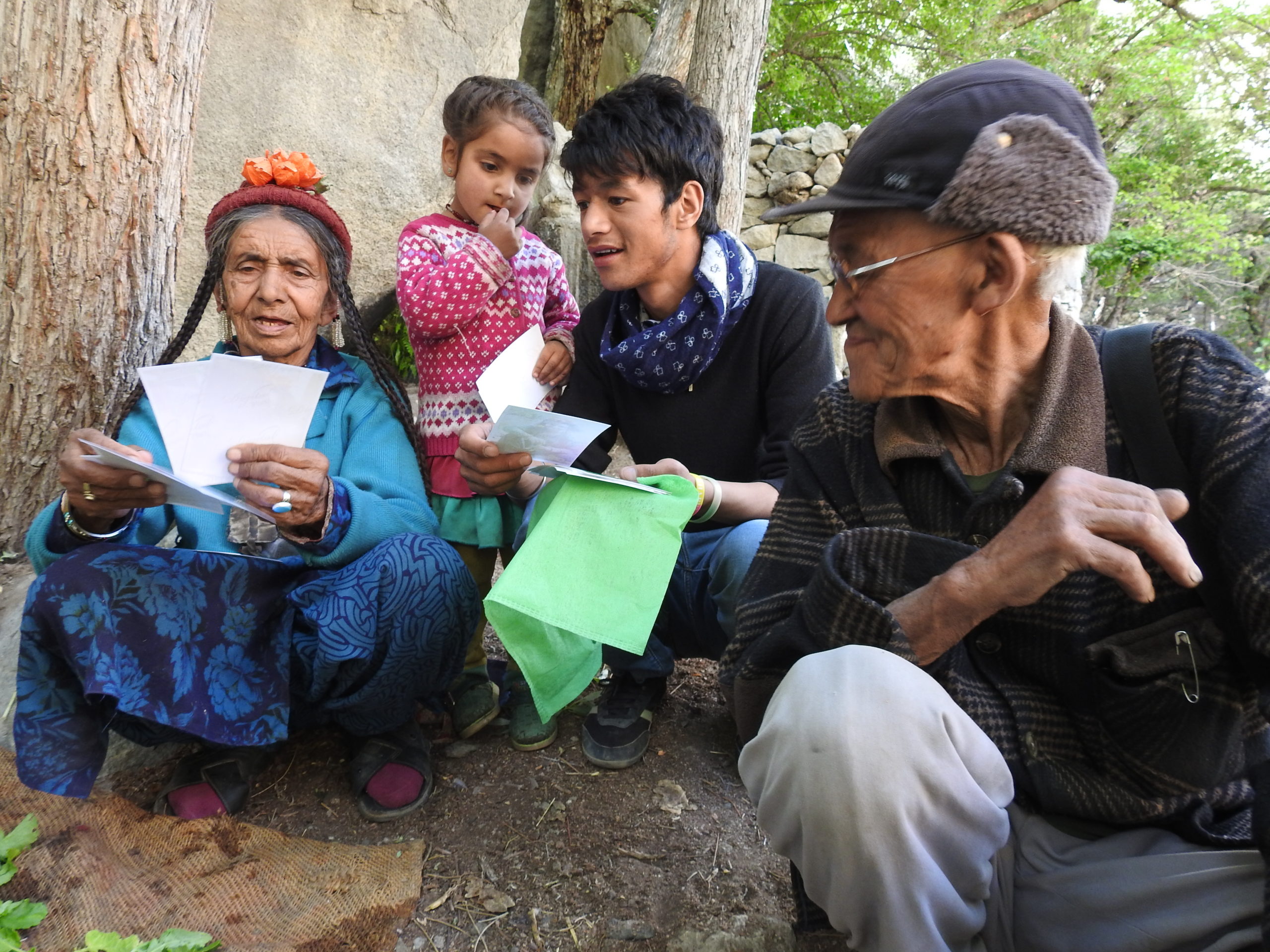SLN Training Initiative – Social Research – Module 4
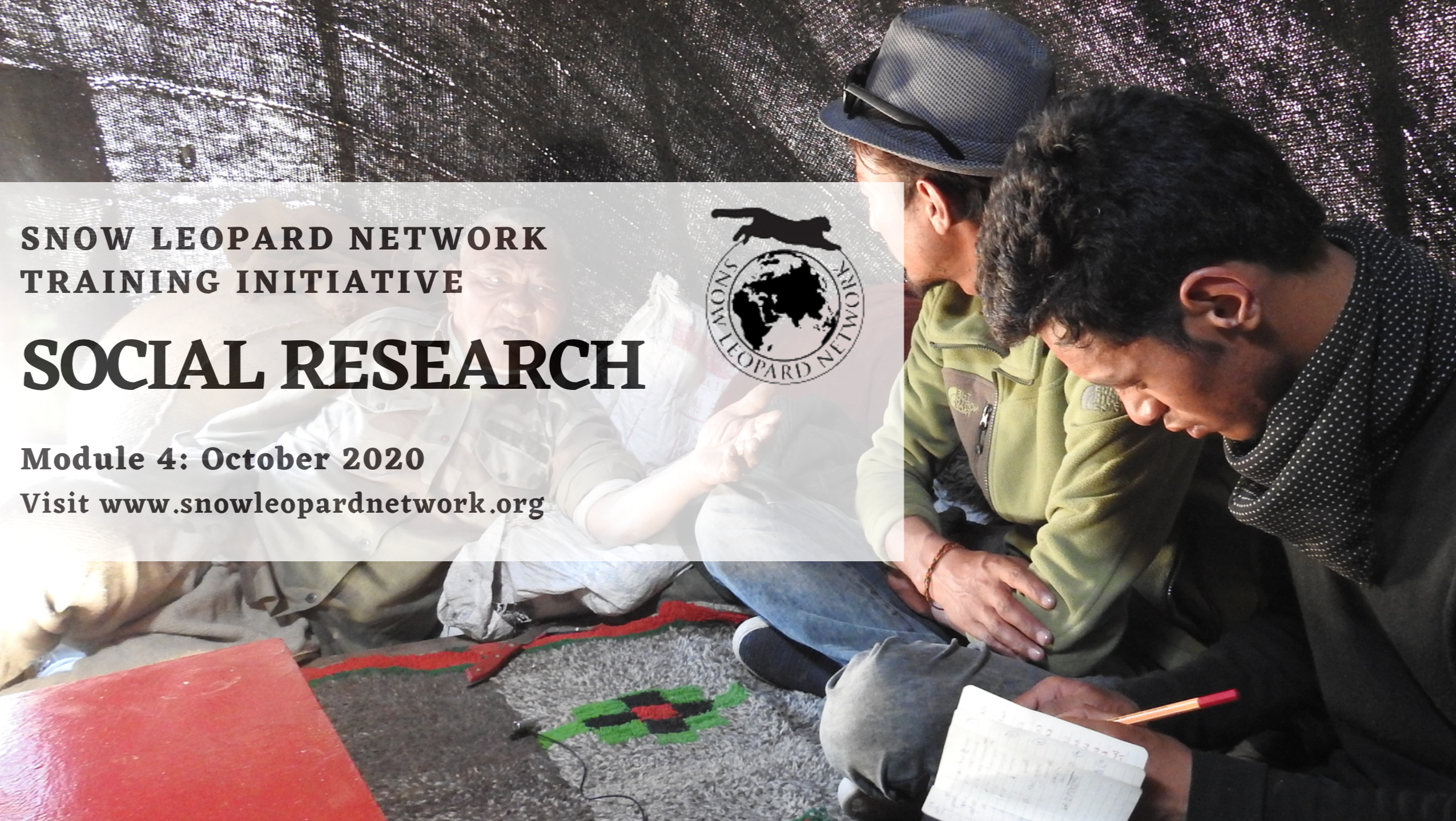
This course is Module 4 of the Snow Leopard Network’s training initiative.
Course Content
Conservation, especially in snow leopard landscapes, occurs at the interface of humans and wildlife. To find workable solutions to these complex environmental issues, understanding local communities and how they interact with the landscape is essential. This course provides a brief introduction to social science theory and methodology for conservation practitioners and researchers working in snow leopard landscapes. It will equip participants to ask research questions and design a study using social survey methods commonly needed by conservationists in the field, such as structured and unstructured interviews.
Knowledge & skills you will gain
-
-
- Understanding the basics of applied social science
- Learning to design a social research study
- Collecting data from human subjects
- Ethics of conducting social science research
-
Meet the trainers
Dr. Saloni Bhatia is an interdisciplinary researcher who has worked in the high-altitude landscapes, first on policy and later, on research issues for close to a decade. She is a Postdoctoral Fellow at Centre for Technology Alternatives in Rural Areas (IIT-Bombay). Her research primarily focuses on the interface between people and wild animals. She completed her PhD from Manipal University and MSc. from University of Oxford.
Dr. Ranjini Murali is the Conservation Scientist at the Snow Leopard Trust. As a part of her role she supports research and conservation work across the snow leopard range. She is also a research associate with the Nature Conservation Foundation and a visiting faculty with the Azim Premji University. She is a Fellow with the Intergovernmental Platform on Biodiversity and Ecosystem Services (IPBES) on the values assessment that assesses the multiple values that humans have for nature. She completed her PhD from Manipal University and her MSc. from the University of St. Andrews.
Criteria for participation
-
- Snow Leopard Network Member
- Experience or willingness to work on snow leopard conservation efforts
- Confirmed availability to attend all the four online seminars of a given module
- Number of participants is limited to 25
- Priority will be given to participants from snow leopard range countries
Planned Schedule
-
- 2 hour online Zoom Seminars take place every Wednesday of the month, October 2020 (4 Seminars; Oct 7th, 14th, 21st, 28th) at 14:00 Bishkek, Kyrgyzstan time.
- Additional group work, assignments or readings are likely to be organized by the trainers
- Please note we expect all participants to attend the complete set of Wednesday Seminars as they are interconnected and build on each other
- Details of each specific Seminar topic will be shared approximately 5 days beforehand; including any expected preparations by participants.
Deadline for Applications
-
- Wednesday, September 16th, 2020. Please note places are limited so please do not delay in applying.
- Please fill in the following APPLICATION Closed
Using Drones To Assess Populations Of Snow Leopard Prey Species – A Preliminary Report and Video
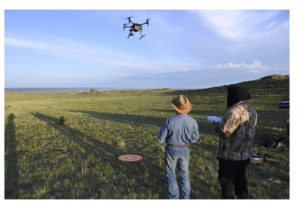
In 2019, a group of researchers traveled to Mongolia to test the utility of employing drone (UAV) technology for assessing the abundance of snow leopard prey species like argali and ibex. Dr. Rodney Jackson, the Snow Leopard Conservancy’s Director was accompanied by Dr. Don Hunter of Colorado’s Rocky Mountain Cat Conservancy, Dr. Bariushaa Munkhtsog of the Mongolian Academy of Sciences, Institute of Biology, and Irbis Mongolia, and videographer Ben Hunter of the Isaacson School for New Media, Colorado Mountain College.
Snow leopards are at risk of extinction due to a wide variety of threats, including retaliatory killing, poaching, prey depletion, and habitat loss and disruption. In order to help this species survive, it’s important to know their numbers, distribution, and characteristic behaviors. However, being an inhabitant of a high-mountain environment snow leopards are very difficult to locate and study. Newer non-invasive research methods like trail cameras and fecal genotyping have been helpful, but there still remains the question as to how many snow leopards and prey remain in the wild – questions which lie at the very heart of the 12 range state GSLEP-supported PAWS program.
Given that it is very difficult and expensive to count the cats, an easier, less-expensive alternative is assessing the abundance of their large prey species like ibex, argali, and blue sheep. Snow leopards and other predators thrive in areas with a healthy and stable prey base. Therefore, one can infer snow leopard population capacity based on the number of available prey, including wild and domestic ungulates (hoofed stock).
Some wild ungulates are easier to observe as they prefer open terrain, but they still occupy a vast habitat. In recent years, drones equipped with infrared thermal (temperature) sensors have proven effective for rapidly surveying more habitat than is possible by a person walking along transects and counting the wildlife observed.
After successfully testing the drone surveying deer (mountain lion prey) in Colorado, the team traveled to Mongolia’s Ikh Nart Nature Reserve in the East Gobi Province and Toost Uul Community Reserve, located in the South Gobi. A commercial-grade drone, the DJI Matrice 210, utilizing thermography and a powerful zoom lens was deployed to detect and assess numbers of argali and ibex along several fixed transects that have been surveyed annually over the last 20 years under a program established by Denver Zoo.
Though preliminary, the results were very encouraging. The drone detected a total of 37 argali in six groups along one 4-km (2.5-mile) transect, as illustrated below. This and other transects are monitored annually by ground observers that walk and note animals one kilometer (approx. 1,100 yards) on either side. However, not all parts of each transect is visible to them. Using GIS and a 30 meter DEM (Digital Elevation Model), we mapped the rough extent of terrain, the “viewshed,” visible to observers walking the transect centerline, indicated by the green-shaded areas. The brown areas were obscured to the ground observers but visible to the drone flying at 100 m (330 feet) above ground level.
As shown in the figure, four of the six argali groups were in areas obscured from human observation, areas such as hidden valleys, gullies or behind rocky outcrops, and thus only visible to the drone flying overhead. The drone covered the entire transect in a fully autonomous 20-minute flight covering the four transect segments shown in black. In all, it was a very promising start to a project that clearly merits continued study.
Click the link below to view a video of the project produced Ben Hunter:
https://www.youtube.com/watch?v=ZSszMTNKN_4&feature=emb_title
This project was supported by a Sabin Foundation grant the Rocky Mountain Cat Conservancy received from Panthera. Thanks also to the SLC donors for their support.
Submitted by Dr. Rodney Jackson, Dr. Don Hunter and Dr. B. Munkhtsog.
Publication Alert – New Article to the Bibliography
Please find details below, of a new article added to our Bibliography:
Title: Understanding population baselines: status of mountain ungulate
populations in the Central Tien Shan Mountains, Kyrgyzstan
Authors: Khanyari, M., Zhumabai uulu, K., Luecke, S., Mishra, C.,
Suryawanshi, K.
Abstract: We assessed the density of argali (Ovis ammon) and ibex
(Capra sibirica) in Sarychat-Ertash Nature Reserve and its neighbouring
Koiluu valley. Sarychat is a protected area, while Koiluu is a human-use
landscape which is a partly licenced hunting concession for mountain
ungulates and has several livestock herders and their permanent
residential structures. Population monitoring of mountain ungulates can
help in setting measurable conservation targets such as appropriate
trophy hunting quotas and to assess habitat suitability for predators
like snow leopards (Panthera uncia). We employed the double-observer
method to survey 573 km2 of mountain ungulate habitat inside Sarychat
and 407 km2 inside Koiluu. The estimated densities of ibex and argali in
Sarychat were 2.26 (95% CI 1.47–3.52) individuals km-2 and 1.54 (95% CI
1.01–2.20) individuals km-2, respectively. Total ungulate density in
Sarychat was 3.80 (95% CI 2.47–5.72) individuals km-2. We did not record
argali in Koiluu, whereas the density of ibex was 0.75 (95% CI
0.50–1.27) individuals km-2. While strictly protected areas can achieve
high densities of mountain ungulates, multi-use areas can harbour
meaningful
though suppressed populations. Conservation of mountain ungulates and
their predators can be enhanced by maintaining Sarychat-like “pristine”
areas interspersed within a matrix of multi-use areas like Koiluu.
URL:
https://snowleopardnetwork
With regards,
Rakhee
Snow leopard research and conservation in Nepal: Past, Present and Future
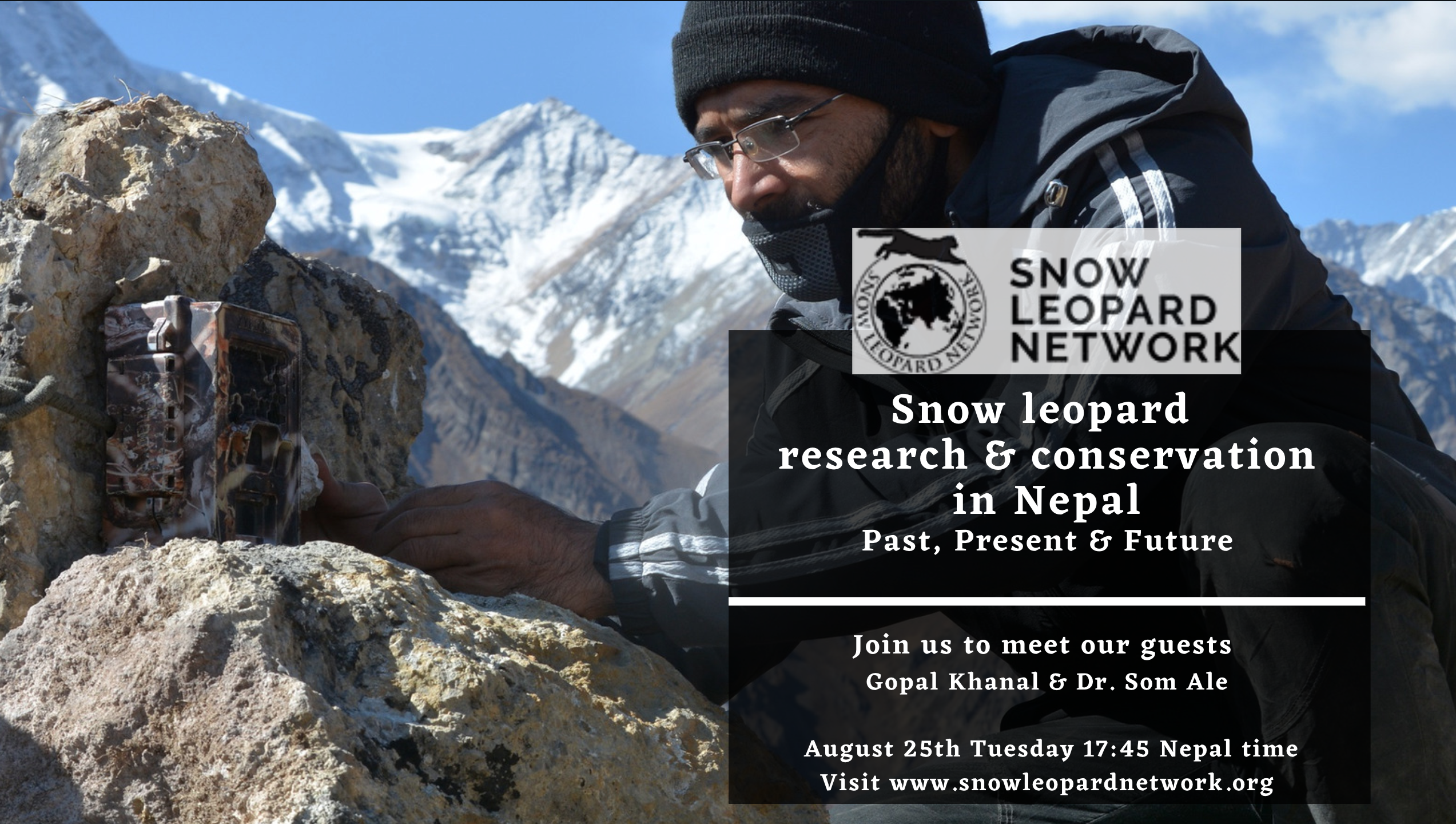
Snow leopard research and conservation in Nepal: Past, Present and Future
The Snow Leopard Network is pleased to announce our fifth SLN webinar of 2020 where we travel to Nepal. This Webinar series aims explicitly to feature snow leopard range country national updates and experience. As our SLN committee chair, Dr. Lu Zhi, suggested as she launched the webinar series – it is a pleasure to take this opportunity to learn from each other and build links between our efforts across the snow leopard range.
Nepal has a long and very special history in snow leopard conservation. Research and conservation efforts in Nepal were path finding for the wider snow leopard community. In this month’s Webinar are delighted to welcome Gopal Khanal who is currently working as Assistant Conservation Officer in Shey Phoksundo, the largest National Park of Nepal home to a significant population of snow leopards. We also will be joined by Dr. Som Ale, a member of SLN’s Committee, who has been working in snow leopard conservation in Nepal for over two decades. Together our guests will bridge past and present with a special focus on community based conservation through the lens of policy and research. We will also look towards Nepal’s snow leopard conservation agenda for the next decade.
More on the talk: Nepal is believed to host 10% of the global snow leopard population. Since the early 1970s Nepal has adopted both an ecosystem approach (establishing protected areas) and species approach to conserve, research and monitor the country’s snow leopards. Gopal will share his thoughts on recent developments and give us insights on some promising recent snow leopard research and conservation efforts in Nepal. Som Ale will join as discussant and provide a longer term perspective of Nepal’s conservation efforts and will set this within future snow leopard conservation priorities.
More about our guests:
Gopal Khanal currently works for Shey Phoksundo National Park office, Dolpa as an Assistant Conservation Officer. He has been working on snow leopard research and conservation in the Nepal Himalayas since 2014. He completed his Master’s degree in wildlife biology and conservation. His master’s thesis examined the influence of wild prey and livestock on snow leopard predation on livestock in Nepal.
Som Ale spent over a decade working as a conservation manager in north central Nepal and was Officer in Charge of Nepal’s National Trust for Nature Conservation – Annapurna Conservation Area Project. Som now lives in the United States and serves as a professor of biology and ecology at the University of Illinois – Chicago. Dr. Ale is passionate about protecting the snow leopard in ways that benefit the animals, environment, culture, and community; and has developed powerful, unique, and engaging conservation initiatives.
Date/Time: August 25th, 2020 Tuesday 17:45 Kathmandu time (Please log into the meeting 5 min early to set up)
Location: ZOOM, to join this talk REGISTER HERE
Please note:
- If you have never used Zoom before, we recommend that you try the link 10 minutes before the start of the lecture.
- During the talk, please keep your microphone muted.
- Please feel free to write questions in the comment area and there will be time for questions/discussion at the end of the talk.
- The Zoom event is limited to 100 participants. Please register for the event and also sign in early to ensure your place.
SLN Webinar- Special Guest- Reflections from the past
Snow leopard conservation: Reflections from the past
We would like to invite you to our fourth SLN webinar of 2020. This webinar takes us back to consider snow leopard conservation efforts over the longer term. We are extremely pleased to welcome our guest Raghu Chundawat who has followed snow leopard conservation since the 1980s and was one of the first to complete a PhD with a focus on the elusive cat. As we look ahead to the future it is important we know where we have come from, what has changed and what hasn’t. Join us for this very special Webinar where we travel to the past and hear important perspectives of conservation developing over this extensive stretch of time.
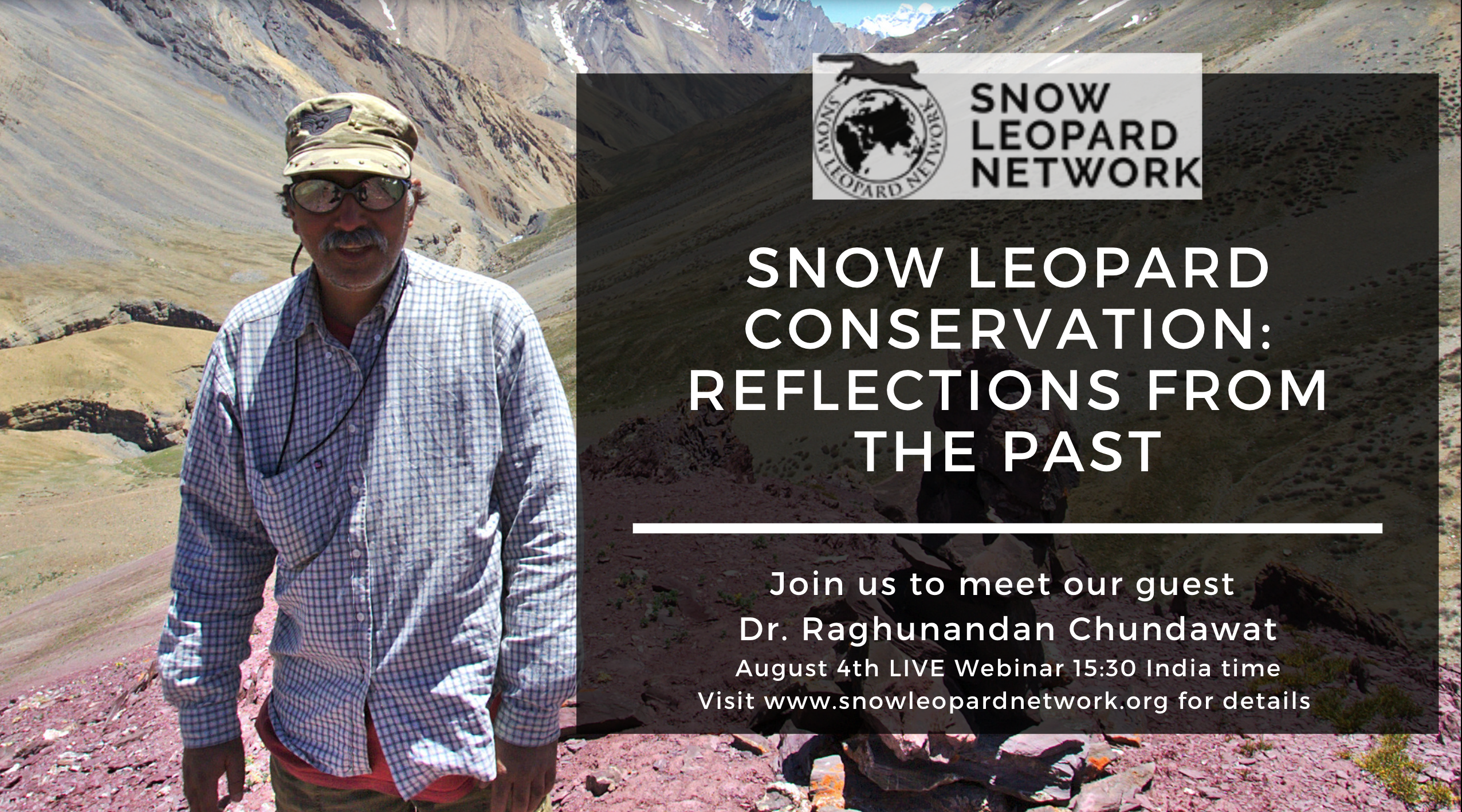
More on the talk: Raghu Chundawat will be sharing reflections on a time when very little was known about the snow leopard. In particular, he will share recollections of the very real challenges of studying snow leopards in the wild. He will share stories from following snow leopards for hundreds of kilometres in the unforgiving rugged mountains. Finally Raghu will give his thoughts on how to support and bring about long term community conservation. Raghu will be joined by Joe Fox who is known for having led one of the first snow leopard surveys in India and who was a key supporter and guide to Raghu’s early conservation work in Ladakh.
Structure: Our guest will be interviewed by Dr. Koustubh Sharma for 30 min followed by a 30 min discussion period. Joe Fox will join as a discussant. During the talk feel free to write questions in the chat section that we can take forward during the discussion section.
More about our guest: Raghu Chundawat is a distinguished conservation biologist who has worked on snow leopard and tiger conservation since the 1980s. His PhD was on snow leopards in Ladakh (1985-93) and he was the Regional Science and Conservation Director of the Snow Leopard Trust (2005-08). He has been a witness—and participant—in the progression of conservation efforts in Ladakh.
Date/Time: August 4th, 2020 Tuesday 15:30 India time (Please log into the meeting 5 min early to set up)
Location: ZOOM, to join this talk REGISTER HERE
Please note:
-
- If you have never used Zoom before, we recommend that you try the link 10 minutes before the start of the lecture.
- During the talk, please keep your microphone muted.
- Please feel free to write questions in the comment area and there will be time for questions/discussion at the end of the talk.
- The Zoom event is limited to 100 participants. Please register for the event and also sign in early to ensure your place.
SLN Training Initiative – Community Conservation – Module 3

This course is Module 3 of the Snow Leopard Network’s training initiative.
Course Content
Engaging and partnering with local communities is critical to the success of conservation efforts. The practical challenges of achieving effective engagement are considerable and conservation practitioners often learn from trial and error.
A set of principles and guidelines for community-based conservation, called the ‘PARTNERS principles’, have been developed based on the extensive experience of snow leopard conservation practitioners. They comprise a set of eight key principles for effectively taking forward community-based conservation programs. The principles have evolved into a workshop and an online toolkit to allow for practitioners to gather and discuss experiences and conservation issues. We hope that these principles will help us reflect on our work and think of how we can work towards developing stronger and more resilient relationships with community partners. If you are a conservation practitioner, or are preparing to work in conservation, the Partner Principles may help you explore, discuss and share different perspectives and approaches to community-based conservation. This module was developed in partnership with the Snow Leopard Trust.
Meet the Trainers
This module has been co-created by a team of snow leopard conservation practitioners. The live training sessions will be led by a subset of this team. Additional special guests from across the snow leopard range will also be invited to share their expertise and experiences.
Ajay supports conservation efforts in the regions of Ladakh and Spiti valley in India. Over the last eight years, he has worked on setting up, running and monitoring community-conservation efforts in these regions. This effort aims at trying to create conditions conducive for conservation. More recently he has also been facilitating the process of building capacity for community-based conservation in snow leopard range countries.
Juliette Young is a Professor at the University of Bourgogne Franche-Comte, where she studies the human dimensions of biodiversity conservation. Much of her work focuses on the role of different actors, especially decision-makers and local communities, in the sustainable use and conservation of biodiversity. She has been working with the Snow Leopard Trust since 2016 on training in community-based conservation.
Justine is the Executive Director of the Snow Leopard Network. She provides support to the evaluation of the efficiency and effectiveness of community conservation initiatives to partners across the snow leopard range. Justine also acts as the Regional Ecologist for the Snow Leopard Trust and supports research and conservation work across in China, Mongolia, Pakistan, India and Pakistan.
Criteria for participation
- Snow Leopard Network Member
- Experience or willingness to work on snow leopard conservation efforts
- Confirmed availability to attend all the four online seminars of a given module
- Number of participants is limited to 25
- Priority will be given to participants from snow leopard range countries
Planned Schedule
- 2.5 hour online Zoom Seminars take place every Wednesday of the month, September 2020 (4 Seminars; Sep 9th, 16th, 23rd, 30th) at 14:00 Bishkek, Kyrgyzstan time.
- Additional group work, assignments or readings are likely to be organized by the trainers
- Please note we expect all participants to attend the complete set of Wednesday Seminars as they are interconnected and build on each other
- Details of each specific Seminar topic will be shared approximately 5 days beforehand; including any expected preparations by participants.
Deadline for Applications
- Friday, August 15th, 2020. Please note places are limited so please do
not delay in applying. - Applications are now closed
Publication Alert – A new note and two articles added to our Bibliography
Note
Title: Woolly flying squirrel Eupetaurus Cinereus: A new addition to the diet of snow leopard Panthera Uncia
Authors: Pal, R., Bhattacharya, T., Sathyakumar, S.
URL: http://snowleopardnetwork.org/bibliography/Pal_et_al_2020_JBNHS_Note.pdf
Articles
Title: Community participation in ecotourism and its effect on local perceptions of snow leopard (Panthera uncia) conservation
Authors: Vannelli, K., Hampton, M. P., Namgail, T., Black, S. A.
Abstract: Local support and involvement is often essential for effective wildlife conservation. This study assessed the impact of local involvement in ecotourism schemes on perceptions of wildlife, promotion of conservation action, types of values that communities placed on wildlife, and contexts in which wildlife are considered to be most valuable. The study used qualitative semi-structured interviews conducted in seven villages in Ladakh, India, which is an important region of snow leopard (Panthera uncia) habitat. Results indicated that in these communities, ecotourism-based interventions encourage more positive perceptions of wildlife species, in particular the snow leopard. Achieving change in community perceptions of wildlife is key when implementing ecotourism schemes to enable more effective conservation, as well as generating local awareness and value for wildlife toward problematic keystone species such as the snow leopard, which are frequently the focus of human-wildlife conflict.
URL: http://snowleopardnetwork.org/bibliography/Vanelli_et_al_2019.pdf
Title: Modelling potential habitat for snow leopards (Panthera uncia) in Ladakh, India
Authors: Watts, S. W., McCarthy, T. M., Namgail, T.
Abstract: The snow leopard Panthera uncia is an elusive species inhabiting some of the most remote and inaccessible tracts of Central and South Asia. It is difficult to determine its distribution and density pattern, which are crucial for developing conservation strategies. Several techniques for species detection combining camera traps with remote sensing and geographic information systems have been developed to model the habitat of such cryptic and low-density species in challenging terrains. Utilising presence-only data from camera traps and direct observations, alongside six environmental variables (elevation, aspect, ruggedness, distance to water, land cover, and prey habitat suitability), we assessed snow leopard habitat suitability across Ladakh in northern India. This is the first study to model snow leopard distribution both in India and utilising direct observation data. Results suggested that elevation and ruggedness are the two most influential environmental variables for snow leopard habitat suitability, with highly suitable habitat having an elevation range of 2,800 m to 4,600 m and ruggedness of 450 m to 1,800 m. Our habitat suitability map estimated approximately 12% of Ladakh’s geographical area (c. 90,000 km2) as highly suitable and 18% as medium suitability. We found that 62.5% of recorded livestock depredation along with over half of all livestock corrals (54%) and homestays (58%) occurred within highly suitable snow leopard habitat. Our habitat suitability model can be used to assist in allocation of conservation resources by targeting construction of livestock corrals to areas of high habitat suitability and promoting ecotourism programs in villages in highly suitable snow leopard habitat.
URL:
http://snowleopardnetwork.org/bibliography/Watts_et_al_2019.pdf
SLN Webinar – Special Guest – PAWS
We would like to invite you to our third SLN webinar of 2020. Having heard updates from China and Mongolia, this month’s Webinar turns towards a global perspective of snow leopard conservation. We are extremely pleased to welcome our guests- Dr. David Borchers and Dr. Koustubh Sharma- who will take us into the world of numbers and statistics about snow leopards in a practitioner friendly way.
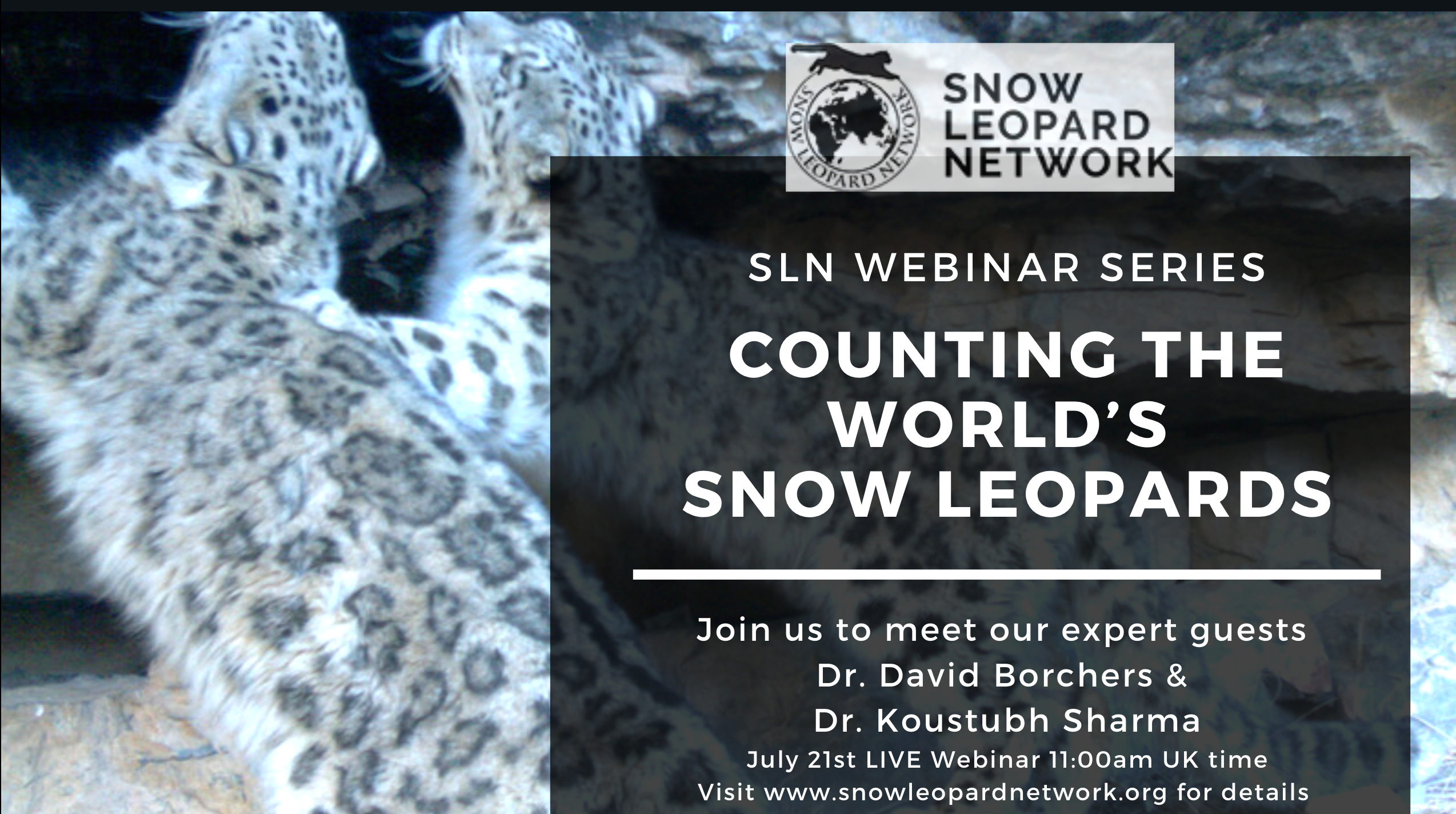
Population Assessment of the World’s Snow Leopards: The Why & How
Assessing the global population of snow leopards remains one of the most challenging endeavours that the snow leopard community is faced with. Developing robust statistical approaches that can count such an elusive species found in Asia’s high altitude and mountainous areas is a key step towards better understanding the species’s ecology and conservation status.
Our speakers, Dr. David Borchers and Dr. Koustubh Sharma, will take us through the Why and the How of assessing the global snow leopard population. We will discover the story of why (and when) the initiative of Population Assessment of the World’s Snow leopards (PAWS) emerged. We will also discuss how PAWS can be achieved, including key ideas of spatial capture-recapture (SCR) and the power of SCR to analyse survey data. Finally we will cover the latest developments in this fast-developing area of research.
Structure: The 30 min presentation by our guest speaker will be followed by a 30 min discussion period. During the talk feel free to write questions in the chat section that we can take forward during the discussion section.
More about our guests:
Dr. David Borchers is a distinguished academic at the University of St Andrews, with more than 30 years experience developing and applying statistical methods to address problems in ecology. His current main research interests focus on spatial capture-recapture and related methods.
Dr. Koustubh Sharma is the International Coordinator of the Global Snow Leopard and Ecosystem Protection Program (GSLEP) and a Senior Regional Ecologist at the Snow Leopard Trust. With nearly 20 years of experience in ecological research, wildlife conservation and training, he helps build collaborations and coordinate alliances and at multiple levels for snow leopard research and conservation.


Date/Time: 21 July, 2020 Tuesday 11:00 am United Kingdom (Please log into the meeting 5 min early to set up)
Location: ZOOM, to join this talk REGISTER HERE
Please note:
-
- If you have never used Zoom before, we recommend that you try the link 10 minutes before the start of the lecture.
- Also note that as of May 30, 2020, all Zoom clients on older versions will receive a forced upgrade when trying to join meetings and this may take time to download.
- During the talk, please keep your microphone muted.
- Please feel free to write questions in the comment area and there will be time for questions/discussion at the end of the talk.
- The Zoom event is limited to 100 participants. Please register for the event and also sign in early to ensure your place.
Publication Alert – Two Books added to the Bibliography
We have added two books to our bibliography.
1. Karnaukhov А. S., Korablev М. P., Kuksin А. N., Malykh S. V., Poyarkov А. D., Spitsyn S. V., Chistopolova М. D., Hernandez-Blanco J. A. Snow Leopard Population Monitoring Guidebook. – WWF. Krasnoyarsk. 2020 – 164 pp. (you can download it by the link: https://wwf.ru/en/resources/publications/booklets/materialy-k-rukovodstvu-po-monitoringu-sostoyaniya-populyatsii-snezhnogo-barsa/) – English version
URL:https://snowleopardnetwork.org/bibliography/Karnaukhov_et_al_2020.pdf
2. Карнаухов А. С. Материалы к руководству по мониторингу состояния популяции снежного барса / А. С. Карнаухов, М. П. Кораблев, А. Н. Куксин, С. В. Малых, А. Д. Поярков, С. В. Спицын, М. Д. Чистополова, Х. А. Эрнандес-Бланко. – Красноярск: Все мирный фонд дикой природы (WWF), 2020. – 168 с. (you can dowlload it by the link: https://wwf.ru/resources/publications/booklets/materialy-k-rukovodstvu-po-monitoringu-sostoyaniya-populyatsii-snezhnogo-barsa/) – Russian version
URL:https://snowleopardnetwork.org/bibliography/Karnaukhov_et_al_2020_ru.pdf

